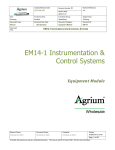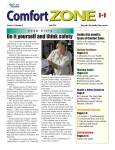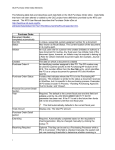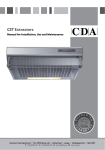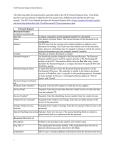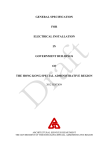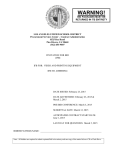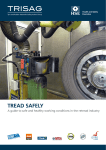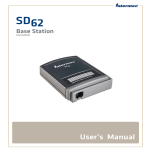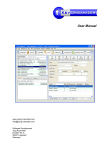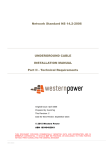Download Electrical Operational Procedure
Transcript
ELECTRICAL OPERATIONAL PROCEDURE LOW VOLTAGE SYSTEMS Contents Section 1 – Electrical Safety Procedure 1 Definitions 1 2 Responsibilities 2.1 Employer/Management Responsibilities 2.1.1 Compliance with Statutes 2.1.2 Managerial Responsibilities for Electrical Systems 2.1.3 Temporary Electrical Installations 2.1.4 Managerial Responsibilities for Employees 2.1.5 Managerial Responsibilities for Contractors 2.2 Employee Responsibilities 7 7 7 7 8 8 8 9 3 Electrical Safety Arrangements 3.1 Electrical Safety Rules for all Employees 3.2 Safety Rules for Competent Electrical Staff 3.3 Authorisation 3.4 Safe Working Procedures 3.4.1 Work Activities 3.4.2 Protective Equipment 3.4.3 Cutting Off Electrical Supplies 3.4.4 Isolation 3.4.5 Safe Working Systems 3.4.6 Live Working 3.5 Safety Documents 3.6 Contractors Working on University Sites 3.7 Generating Plant and Batteries 3.7.1 Work on Generating Plant 3.7.2 Commissioning of Mobile Generating Plant 3.7.3 Work on Batteries 3.8 Underground Cables and Overhead Lines 3.8.1 Work on Cables 3.9 Portable Electric Equipment 3.9.1 Recording 3.9.2 Flexible Power Supply Cables 3.9.3 Mains Operated Portable Equipment Used Outside the Building 3.9.4 Regular Planned Inspection and Testing 3.9.5 Hazardous Areas 10 10 11 14 14 14 14 14 14 15 15 16 16 17 17 18 18 19 19 19 19 19 19 20 21 4 Fire Protection Equipment for Electrical Equipment 4.1 Fixed Automatic Equipment 4.2 Portable Extinguishers 4.3 General 22 22 22 22 5 Review 22 6 List of Supporting Documents 23 Y:\Health and Safety\Health & Safety\Policies and COP\Electrical Operational Procedure 2012.doc APPENDICES Appendix 1 Duty Holders 24 Appendix 2 Form of Completion and Inspection Certificate 25 Appendix 3 Schedule of Inspection and Test Results 31 Appendix 4 Portable Equipment, Inspection and Test Record 32 Appendix 5 Authorisation for the Interruption of Engineering Services 33 Y:\Health and Safety\Health & Safety\Policies and COP\Electrical Operational Procedure 2012.doc Section 1 Electrical Safety Policy Operating Procedure 1. Definitions In these procedures, unless the context otherwise requires, the following words shall have the following meanings. Authorising Engineer (Low Voltage) A Chartered Engineer with appropriate experience or an Incorporated Electrical Engineer who possesses the necessary degree of independence from local management and is appointed in writing by management to implement, administer and monitor the safety arrangements for the low voltage electrical supply and distribution systems of the organisation to ensure compliance with the Electricity at Work Regulations and to assess the suitability and appointment of candidates in writing to be ‘Authorised Persons’ These Authorised Persons will be: a) b) c) d) e) Duty Holder Deputy Duty Holder Authorised Persons Competent Persons Named Persons. Authorised Person An individual, appointed in writing, who, in the opinion of an Authorising Engineer has: a) Technical knowledge: adequate knowledge of electricity, adequate experience of electrical work, adequate understanding and practical experience at Northumbria University, understanding of the hazards which may arise during the work and the precautions which need to be taken, ability to recognise at all times whether it is safe for work to continue. b) Qualifications: City and Guilds Accredited Course Authorised Person Electrical Low Voltage. Charged When the electrical equipment has acquired a charge either because it is live and/or has retained/regained a charge even though it may be disconnected from the rest of the system. Circuit Conductors Means any conductor in a system which is intended to carry electric current in normal conditions, or to be energised in normal conditions, and includes a combined neutral and earth conductor, but does not include a conductor provided solely to form a protective function by connection to earth or other reference point. Competent Person An individual, appointed in writing, who, in the opinion of an Authorising Engineer has: a) Technical knowledge: adequate knowledge of electricity, adequate experience of electrical work, adequate understanding and practical experience at Northumbria University, understanding of the hazards which may arise during the work and the precautions which need to be taken, ability to recognise at all times whether it is safe for work to continue. b) Qualifications: City and Guilds 1 & 2 Certificate in Installation and Theory or NVQ Level 1 & 2 in Electrical Installation and a recognised qualification in BS 7671 17th Edition Electrical Wiring regulations and completed an indentured electrical apprenticeship. Complex Low Voltage System A system which is normally operated at low voltage and which requires more than one point of isolation to ensure safety at the point of work. 1 Conductor Means a conductor of electrical energy. Contractors An individual, appointed in writing, who, in the opinion of an Authorising Engineer has: a) Technical knowledge: adequate knowledge of electricity, adequate experience of electrical work, adequate understanding of the system to be worked on and practical experience of that class of system, understanding of the hazards which may arise during the work and the precautions which need to be taken, ability to recognise at all times whether it is safe for work to continue. b) Qualifications: Appropriate accreditation such as NICEIC or ECA. Electrical Contractors will abide by all Electrical Safety Operating Procedures and House Rules. All contractors are required to be registered with the Contractors Health & Safety Scheme (CHAS) who carry out the pre-qualification safety checks on behalf of the University. Circuit Conductor Any conductor in a system, which is intended to carry electrical current in normal conditions, but does not include a conductor provided solely to perform a protective function by connection to earth or other reference point. Connected Equipment Equipment connected into the low voltage system utilising electrical power to per form its dedicated function. Danger Means a risk of injury. Dangerous Condition A condition that is likely to lead to a dangerous occurrence. Dangerous Occurrence An incident which involves a source of electrical energy and that gives rise to danger to any person. Dead Neither live nor charged. Designated Person The Director of Campus Services has overall authority and responsibility for the low voltage electricity system within the premises, and who has a duty under the HSW Act to prepare and issue a general policy statement on health and safety at work, including the organisation and arrangements for carrying out the policy. This person should not be the Authorising Engineer. Distribution Control Engineer An engineer employed by a regional electricity company and specifically authorised by the company to exercise the function of control over the company's switching operations. Duty Holder The Duty Holder has imposed duties in connection with safety in the Electricity at Work Regulations and is required to ensure that: a) suitable and sufficient risk assessments are carried out with respect to risk to persons and property for the operation and maintenance of the LV network. 2 b) all LV systems are operated and maintained so as to prevent, so far as is reasonably practicable, danger to persons or property. c) the appointed competent person has the appropriate training, knowledge and experience to prevent danger. d) only persons authorised to work on the LV network do so. All such authorised persons (University employees or otherwise) shall have the technical knowledge and experience to prevent injury unless such persons are under such degree of supervision as may be appropriate having regard to the nature of the work. e) any consultants appointed to advise on the LV network can demonstrate their competence with respect to knowledge, skills and training and have sufficient resource. f) all University employees authorised to work on the LV network have the appropriate initial and refresher training. g) the maintenance contract for the inspection and testing of the University’s LV installations is carried out in accordance with the maintenance contract. h) those who undertake supervision of others, whose technical knowledge or experience is insufficient for them to undertake the work safely, are aware of their responsibilities. The degree of supervision and the manner in which it is exercised is for the duty holder to arrange to ensure that danger or injury is prevented. i) the effectiveness of LV maintenance policies is monitored. Without effective monitoring the duty holder cannot be certain that the requirement for maintenance of the LV system has been complied with. j) all the above duties are discharged subject to sufficient resources being available and responsible for alerting the line management if resources are insufficient to discharge these duties. Deputy Duty Holder The Deputy Duty Holder assumes the responsibilities of the Duty Holder in their absence. Earthing a) Earth - The conductive mass of the earth, whose electric potential at any point is conventionally taken as zero. b) Earthed - Connected to the general mass of earth in such a manner as will ensure at all times an immediate discharge of electrical energy without Danger. When applied to electrical equipment and circuit conductors, all phases short-circuited and efficiently connected to earth. c) Circuit Main Earth – safety earthing connection of an approved type applied by an Authorised Person and its position recorded before the issue of a safety document. d) Additional Earth - earthing equipment of an approved type which is applied after the issue of a safety document (for example, an earth applied at a point of work). Electrical Equipment Includes anything used, intended to be used or installed for use to generate, provide, transmit, trans form, rectify, convert, conduct, distribute, control, store, measure or use electrical energy. Emergency Disconnection The operation of switchgear or other methods of breaking circuit conductors to prevent injury without the need to alter the schematic diagram. Employer Any person or body who: a) Employs one or more individuals under a contract of employment or apprenticeship; 3 b) Provides training under the schemes to which the Health & Safety (Training for Employment) Regulations apply. Equipment Abbreviation of electrical equipment. Injury Means death or personal injury from electric shock, electric burn, electrical explosion or arcing, or from fire or explosion initiated by electrical energy, where any such death or injury is associated with the generation, provision, transmission, transformation, rectification, conversion, conduction, distribution, control, storage, measurement or use of electrical energy. Isolated The disconnection and separation of electrical equipment and circuit conductors, by use of an isolating device or alternative means, from every source of electrical energy in such a way that its disconnection and separation is secure. Isolating Device A purpose-designed item of equipment which provides a secure method of disconnecting and separating electrical equipment and/or circuit conductors from every source of electrical energy. Live Implies connection to a source of electricity. Logbook A pro- forma logbook for LV network switching in which should be recorded: a) all switching operations and precautionary measures taken. b) the issue of safe-to-work permits, live working permits and limitation-of-access safety documents. c) safety programme serial number. d) Dangerous occurrences as required to be reported by the Reporting of Injuries, Diseases and Dangerous Occurrences Regulations (RIDDOR). Other unusual occurrences should be recorded in this logbook. Management The owner, occupier, employer, general manager, chief executive or other person who is accountable for the premises and who is responsible for issuing or implementing a general policy statement under the HSW Act. Mimic Diagram A permanently displayed single line circuit diagram contained in a lockable enclosure. It shows the principle elements of the low voltage system, with facilities for altering the switch and circuit breaker symbols, etc to show whether each such unit is switched to on (closed), switched to off (open) or switched to earth. Named Person An individual who has: a) received the necessary training, b) the necessary knowledge and experience, and c) been given permission in writing to carry out defined duties. These duties should be defined in a certificate of appointment or a limitation-of-access certificate, but not safe-towork permits or certificates of authorisation for live working. Contractors will abide by all Electrical Safety Operating Procedures and House Rules. 4 Notices a) Caution Notice - a notice in approved form attached to electrical equipment conveying a warning against interference with such equipment, stating for example ‘CAUTION DO NOT INTERFERE’. b) Danger Notice - a notice in approved form attached to electrical equipment or sections when live, calling attention to the danger of approach to or interference with such equipment or sections, stating for example ‘DANGER LIVE EQUIPMENT’. Operational Restriction A specific written instruction, issued by the authorising engineer or by the Department as appropriate, modifying the normal operating procedures associated with a particular type of equipment, for example ‘Safety Action Bulletin’, ‘Hazard Notices’ etc. Reasonably Practicable Where a statement is qualified by the words ‘reasonably practicable’, a slightly less strict standard is imposed. This means that an assessment must be made considering, on the one hand, the magnitude of the risks of a particular work activity or environment and, on the other hand, the cost in terms of the physical difficulty, time, trouble and expenses which would be involved in taking steps to eliminate or minimise these risks. The greater the degree of risk, the less weight that can be given to the cost of measures needed to prevent that risk. Safety Documents (One of the following): a) Limitation of Access - a safety document that is issued and cancelled by an Authorised Person. It defines the limits and nature of work that may be carried out in the vicinity of live electrical equipment. b) Safe-to-Work Permit (LV) - a safety document that is a form of declaration signed and issued by an authorised person, to a person in charge of work to be carried out on any complex low voltage system or equipment. It defines the scope of the work to be undertaken and makes known to such person exactly what equipment is dead, isolated from all live circuit conductors and safe to work on. c) Live Working Permit - a safety document that is a form of declaration signed and issued by an authorised person to a person in charge of the work to be carried out live. It makes known to that person exactly what equipment should be worked on, with details of the work to be undertaken live, what safety equipment is to be used and the safety precautions to be taken. d) Permit-to-Work (HV) - (for use on high voltage systems) a safety document that is a form of declaration signed and issued by an authorised person (high voltage), to a person in charge of work to be carried out on any high voltage electrical equipment. It makes known to such person exactly what equipment is dead, isolated from all live circuit conductors, has been discharged, is connected to earth, and is safe to work on. e) Permission for Disconnection - a safety document that is a form of declaration signed and issued by an authorised person to a person in charge of the work to be carried out to disconnect an electrical installation. It makes known to such a person exactly what process to follow to safely disconnect the installation. f) Isolation and Earthing Diagram - a safety document that is a form of declaration signed and issued by an authorised person to a person in charge of the work to be carried out to isolate an electrical installation. It makes known to such a person exactly what process to follow to safely isolate the installation. 5 g) Safety Programme - a safety document that is a form of declaration signed and issued by an authorised person to a person in charge of the work detailing the step by step process the person is required to follow to undertake their work safely. Safety Sign A sign that gives a message about health or safety by a combination of geometric form, safety colour and symbol or text (that is, words, letters, numbers) or both: a) A Prohibition sign - a safety sign indicating that certain behaviour is prohibited. b) A Warning Sign - a safety sign that gives warning of a hazard. Sub-Station Any premise or part of premises or enclosure, in which electrical energy is transformed or converted to or from high voltage, or which contains high voltage switchgear. Shall Where ‘shall’ is used in this Safety Policy with no qualifications, this indicates a mandatory requirement with no discretion permitted and no judgement to be made. Supervision a) Immediate Supervision - supervision by a person (having adequate technical knowledge, experience and competence) who is continuously available at the location where work or testing is in progress, and who attends the work areas as is necessary for the safe performance of the work or testing. b) Personal Supervision - supervision by a person (having adequate technical knowledge, experience and competence) who is, at all times, during the course of the work, in the presence of the person being supervised. Switching The operation of circuit breakers, switchgear or other methods of making (closing) or breaking (opening) circuit conductors and/or the application and removal of circuit main earth connections. Switching Devices (switchgear) Equipment which is designed and manufactured specifically for the task of switching. System An electrical system in which all the electrical equipment is, or may be, electrically connected to a common source of electrical energy, and includes such source and such equipment. Voltage Categories a) Low Voltage (LV) - the existence of a potential difference (rms value for ac) not exceeding 1000 volts ac or 1500 volts dc between circuit conductors, or 600 volts ac or 900 volts dc between circuit conductors and earth. (This definition for low voltage incorporates the extra low voltage range as defined under the IEE Wiring Regulations). b) High Voltage - the existence of a potential difference (rms value for ac) normally exceeding 1000 volts ac between circuit conductors or 600 volts ac between circuit conductors and earth. 6 2. Responsibilities 2.1 Employer/Management Responsibilities 2.1.1 Compliance with Statutes It will be the responsibility of the Board of Governors to ensure that Northumbria University complies with all statutes. 2.1.2 Managerial Responsibilities for Electrical Systems Managers of Northumbria University have, under the requirements of the Health and Safety at Work Act 1974 and the Electricity at Work Regulations, to ensure so far as is reasonably practicable the following are adhered to: a) Provision of adequate in formation, supervision and instruction to ensure that work with electrical systems can be carried out safely. b) Provision of a safe place of work, including adequate working space, access and lighting. c) The design and purchase of new equipment and extensions to existing equipment and extensions to existing electrical systems shall be carried out by persons with the appropriate technical knowledge, experience and understanding of current regulations, standards, (British or Harmonised European), and established Codes of Practice. d) All items of Electrical Equipment shall be selected to take account of the environment in which they are to be installed / used. e) All new electrical installation work shall be inspected and tested prior to handover or putting into service. The inspection and test results shall be recorded on forms as shown in Appendix 2 and 3. f) All equipment shall be clearly labelled, particularly switchgear and fuse boards, for circuit and identification purposes. g) Circuit diagrams and plans shall be maintained to provide a comprehensive record of all electrical systems, and arrangements shall exist for updating following systems modifications. h) All electrical systems shall be periodically inspected and tested and appropriate records maintained as shown in Local House Rule HR15. i) All electrical systems shall be maintained as appropriate to prevent danger so far as is reasonably practicable. j) Strict guidelines shall be established for the purchase, use and maintenance of portable electrical equipment. k) All portable electrical equipment shall be periodically inspected and tested and records maintained as shown in the University Code of Practice for the inspection & Testing of Portable Appliances. http://www.northumbria.ac.uk/static/worddocuments/estates/pat_2009.doc 7 2.1.3 Managerial Responsibilities for Temporary Electrical Installations Temporary electrical installations shall be managed as follows: a) Temporary electrical installations shall con form to the safety standards of permanent installations. b) Temporary electrical installations shall be in the charge of an Authorised Person. Such installations shall be inspected at intervals not exceeding 3 months. c) A register of all Temporary Electrical Installations as shown in Appendix 1 shall be maintained by an Authorised Person. The register shall include: i) ii) iii) designation of installation and date when installed. the Authorised Person in charge of the maintenance of the temporary electrical installation. date of last Inspection. 2.1.4 Managerial Responsibilities for Employees The University recognises there are different levels of competency in relation to electrical work. Accordingly: a) No person shall be engaged in any work activity for which they do not possess the appropriate technical knowledge or experience necessary to prevent danger. b) It is the policy of the employer to authorise only such employees as possess the appropriate technical knowledge necessary to prevent danger. c) Duty holders shall receive such training as is appropriate to the work they are required to do. From time to time, such persons shall receive refresher training as is deemed necessary by the employer. d) Only Authorised or Competent Persons shall undertake work on any electrical system. e) Any Authorised or Competent Person carrying out work on an electrical system shall adopt approved safe working procedures so as not to give rise to danger. 2.1.5 Managerial Responsibilities for Contractor Before any installation work is undertaken by contractors on an existing system or installation for which the management has control of the danger, the person responsible for that installation work is required to liaise directly with the Authorised Person (LV) to ensure that the work is undertaken in accordance with the Electrical Safety policy, Electrical Safety Operational Procedure and House Rules. To ensure contractors hold the necessary qualifications, it is a pre-requisite that all contractors working on University electrical systems are members of a professional body such as the ‘National Inspection Council for Electrical Installations Contracting’ (NICEIC) or the ‘Electrical Contractors Association’ (ECA) or other approved independent associations. In addition, contractors must meet any additional general health and safety competency requirements set by the University. All contractors are required to be registered with the Contractors Health & Safety Scheme (CHAS) who carries out the pre-qualification safety checks on behalf of the University. 8 2.2 Employee Responsibilities The duties placed on the employee are equivalent to those placed on the employer in situations which are in his / her direct control. Employees must not put themselves in danger as a result of their lack of competence to carry out the tasks they are attempting. Employers are responsible for the safety of themselves and others at the place of work. It shall be the duty of every employee while at work: a) To comply with the provisions of the specified statutory regulations so far as they relate to matters within their control. b) To co-operate with the employer, through the management and supervisory staff so far is necessary to enable the employer to perform on and comply with the provisions of the Electricity at Work Regulations 1989. c) To undertake work in connection with electrical systems only where competent to do so. d) Appreciate the dangers involved in the work being undertaken. e) Recognise when such dangers are present. f) Undertake and implement safe working practices which remove the danger. g) Understand the different types of injury that could occur if the working methods used are faulty or ineffective. h) Receive sufficient first aid training so as to treat injuries caused by contact with electricity and electrical plant and machinery. REMEMBER: NEVER WORK ON ELECTRICAL SYSTEMS UNLESS YOU HAVE RECEIVED THE NECESSARY TRAINING, HAVE THE APPROPRIATE EXPERIENCE AND HAVE BEEN AUTHORISED TO UNDERTAKE THE WORK. 9 3. Electrical Safety Arrangements 3.1 Electrical Safety Rules for All Employees It shall be the duty of all persons under the control of the employer to comply with these rules. a) Only employees who are competent shall carry out work on electrical systems and equipment. b) All portable electrical equipment procured by the University shall be inspected and/or tested. c) The Deans/Directors shall be responsible for ensuring compliance with the Electrical Safety Policy. d) Portable electric equipment shall be checked and inspected as follows: i) All equipment shall be checked prior to being brought into use and a record maintained. ii) Details, including serial number and manufacturer of the equipment are to be recorded. iii) The equipment is to be labelled with its own unique identification marking and the date on which it is next due for examination and testing. iv) A comprehensive Asset Register is to be maintained which shall be used to identify each item of equipment and to instigate the mandatory periodic inspections and safety tests by appropriately trained staff. v) Portable power tools and equipment (other than office equipment) shall be inspected and tested at a frequency determined by an Authorised Person, and a record shall be maintained. vi) Portable office equipment shall be tested and examined at a frequency determined by an Authorised Person, and a record shall be maintained. vii) Employees and students privately owned electrical equipment shall not be connected to the employer’s system unless the equipment has been tested and approved for use by an Authorised Person, and must subsequently comply with clauses v) and vi). viii) All portable tools purchased subsequent to issue of this document shall be operated at a voltage of 110v or less, supplied via a safety isolating trans former (centre tapped to earth) and/or supplied via a 30mA residual circuit breaker. All hand-lamps operating at mains voltage are forbidden. ix) All items of portable equipment such as luminaries shall be inspected each time they are returned to stores. No such equipment may be removed from stores unless it has been visually inspected. x) All employees shall be vigilant for any latent defects in electrical equipment, and report such to their Manager. Equipment known to be defective must not be used and must be kept in a secure place or immobilised pending repair or replacement. 10 xi) Extension leads are deemed not appropriate for electrical supplies. Where extension leads are used for maintenance and repairs they shall be visually inspected and mechanically protected for the environments in which they are used. The above should be implemented in conjunction with the University’s Code of Practice for the Inspection and Testing of Portable equipment. IF IN DOUBT ASK YOUR MANAGER 3.2 Safety Rules for Competent Electrical Staff A copy of the full Electrical Safety Policy for low voltage systems shall be issued to all University employed Competent Electrical staff. Extracts from the above rules are: a) Injuries or Dangerous Occurrences All injuries or dangerous occurrences resulting from electrical accidents must be reported to an authorised person who prepares a report under RIDDOR. Equipment defects shall be reported through the appropriate reporting procedure. All reports shall then be submitted to the Authorising Engineer. b) Failure of Supply During failures of supply, all equipment and circuit conductors shall be regarded as being LIVE until ISOLATED and shall be checked with a potential indicator. c) Safety Poster Where persons are at a greater risk from electric shock, Treatment for Electric Shock posters shall be displayed e.g. main switch rooms and sub-stations. Posters displaying abstracts from the electrical safety rules may also be provided at these locations as a reminder of the requirements of the Regulations. d) Emergency Resuscitation and First Aid for Electrical Engineers All persons working on LV electrical systems and those who may be required to exercise resuscitation techniques must receive proper training and regular practice. Admittance to Sub-Stations e) All sub-stations shall be kept locked when unattended. If a sub-station contains both LV and HV electrical equipment which is not segregated, access is only allowed providing the person is accompanied by a HV Authorised Person or HV Competent Person or is in possession of a limitation-of-access permit issued by an HV Authorised Person/Competent Person. 11 f) Access to Low Voltage Switchgear Rooms, Enclosures etc. i) ii) All access doors are to be kept securely locked when unattended. No person other than those designated are allowed access unless they are accompanied by any of the following: Authorised Persons Competent Persons Named Persons where appropriate. Where ‘automatically controlled fire protection’ is installed the requirements in i) below shall be adhered to. g) Action in an Emergency If a mimic diagram is provided, the first Authorised Person on a site shall display the ‘Work on Low Voltage System in Progress’ notice and lock the ‘Authorised Person on Site’ sign in the exposed position. All other staff shall take no action until contact has been made with the Authorised Person who displayed the notice. h) Coolant and Arc Extinguishing Media Work on any equipment containing alternatives to hydrocarbon insulating oil should be carried out in accordance with any special instructions specified by the manufacturer. i) Fire Protection Equipment Automatic Control – before work is carried out in enclosures containing automatic equipment the automatic control shall be rendered inoperative and a ‘Caution’ notice displayed. Any precaution taken shall be noted on any safety document being issued. The automatic control shall be restored when work has been completed. Portable extinguishers - only CO2 or Dry Powder extinguishers are to be discharged in an enclosed space after an explosion or fire. The space must be thoroughly ventilated be fore entry of personnel, unless suitable breathing apparatus is worn. j) Working on Equipment Made Electrically Dead Whenever practicable work shall be carried out on equipment or cables that have previously been made electrically dead. Before any such work is carried out, the associated isolating switches shall be locked in the OFF position and the equipment or cables shall be tested to verify that they are electrically dead. Lockable stop buttons shall not be used as means of isolation. Particular attention shall be given to isolating all inter-connecting circuits that could become electrically live due to the operation of auxiliary or automatic controls. 1Caution" notices shall be fixed at all such isolation points when work is being carried out. Other precautions such as screening of live conductors to prevent danger from inadvertent contact shall be taken where appropriate. If fuses or links are the means of 12 isolation these shall be removed and retained by the person responsible for carrying out the work. Circuits that have been connected or re-connected to a low voltage system shall be correctly phased out before the system is re-energised. k) Working on Live Equipment and Functional Testing The employer recognises the requirements of Regulation 14 of the Electricity at Work Regulations 1989, which states: No person shall be engaged in any work activity on or so near any live conductor (other than one suitably covered with insulating material so as to prevent danger) that danger may arise unless: a) It is unreasonable in all the circumstances to be dead, and b) It is reasonable in all circumstances to be at work on or near it whilst it is live, and c) Suitable precautions (including where necessary the provision of suitable protective equipment) are taken to prevent injury. It is the Employer's policy objective to suitably cover all exposed live conductors. Live functional testing may be undertaken, when it has been decided it is not practicable to carry out the test with the conductors electrically dead. Subsequently repair work must be carried out with the equipment rendered electrically dead. No person shall work alone on or near live equipment or cables, with the exception of testing at Distribution Boards and control panels. Only tools in a sound condition and preferably which are insulated shall be used. Rubber gloves and rubber mats shall also be used. Where current trans formers are installed in conjunction with auxiliary apparatus or test equipment, in no circumstances shall the secondary winding be open circuited whilst the primary winding is still electrically live. l) Distribution Switchrooms Switchrooms are to be kept free of all obstruction (e.g. surplus material or spares) to minimise the possibility of persons falling while carrying out work on or inspecting live equipment, and also to allow ease of access for operation of switches. m) Circuit Identification When circuit rearrangements or additions are carried out the identities on switches and distribution boards shall be updated. In these cases new labels shall be prepared in advance and shall be fixed in position immediately the circuit rearrangement or additions are completed. When such rearrangements or additions are made all records shall be immediately updated. 13 3.3 Authorisation Appointments It shall be the duty of the Director of Finance on behalf of the University to appoint in writing a Senior Person as Designated Person, and to appoint in writing an Authorising Engineer who shall in turn appoint in writing sufficient Authorised Persons to provide the necessary cover for all systems and installations. 3.4 Safe Working Procedures 3.4.1 Work Activities The Electricity at Work Regulations require that all work activities shall be carried out in ways which do not give rise to danger. This covers the whole range of work that may be carried out whether electrical or not. The duty of employees to comply with the Electricity at Work Regulations applies to all work activities without exception, and includes work to an electrical system from which danger could arise. The Regulations must be followed so far as is reasonably practicable. 3.4.2 Protective Equipment Equipment provided to protect those working on or near electrical equipment must be suitable for its intended use, maintained in good condition, and properly used. 3.4.3 Cutting off Electrical Supplies If an electrical system is to be made safe for work, the electrical system should be isolated and locked off, thus careful and correct identification of switches is necessary. As well as switching off, the person working on the system must ensure that the supply is not restored whilst he/she is at work. Therefore, there must be a system of isolation. 3.4.4 Isolation Every electrical installation will have a mains position where switches can be used to cut off supply to the required part of the installation. In small installations, it may be necessary to either remove a fuse or operate a circuit breaker to provide the cut-off. On larger installations, the switch required may be remote from the area being worked on. In this case it may be necessary to withdraw a fuse or to switch a circuit breaker off to effect removal of the supply, and secured against unauthorised operation. It is the person concerned who must be quite sure that the correct circuit has been made dead. The worker must not assume that, because a certain fuse has been removed or a circuit breaker switched off, the circuit concerned is dead and is safe to work on. The circuit must be tested to ensure it is dead. Isolation and testing of a circuit is always a requirement in addition to switching off. 14 3.4.5 Safe Working Systems Working with the system ‘dead’ is the preferred method whilst working on an electrical installation. A circuit must always be assumed ’live’ until proved DEAD. The full procedure is detailed in the House Rules. On completion of the work, safety precautions listed should be removed in reverse order once the Competent Person is satisfied that it is safe to do so. 3.4.6 Live Working Live working on any electrical installation, which is not made safe by suitable isolation, is not permitted by the Electricity at Work Regulations 1989 unless: a) It is unreasonable in all the circumstances for the system to be dead. b) It is reasonable in all the circumstances for work to be carried out whilst the system is live. c) Suitable precautions, including the provision of suitable protective equipment where necessary, are taken to prevent injury. d) A Competent Person is carrying out ‘Testing and Diagnostic’ work. Refer to House Rule 4. There must never be live working unless there is absolutely no way of avoiding it. Note: It must be pointed out that inconvenience to others due to the loss of their electrical supply is not a satisfactory defence in the event of a legal action following an accident. Where live working is really unavoidable, proper precautions must be taken to avoid accidents and injury, and it will be up to the Authorised Person to justify the decision to work live and to demonstrate that all possible precautions were taken. If all the necessary safety precautions cannot be taken, there will be no option but to switch off the supply and to work on a dead system. The Authorised Person must assess the risk and take precautions, which will depend on the level of risk. If they feel they do not have the knowledge and experience to judge the case, they must seek advice from the Authorising Engineer. Live working is a specialised field, which should not be undertaken by those not fully trained and totally conversant with the dangers. The following functional tests may be carried out by Competent Persons on a live conductor. a) Removing doors or covers to equipment, distribution boards, bus-bars etc. to check for voltage. b) Attaching current clamp C.T’s for load/current monitoring. c) Testing and Diagnostic purposes by a competent person. 15 When live working is carried out, the following precautions should be observed: a) only fully trained and competent persons must be involved. b) they must be provided with suitable equipment, protective clothing and insulated tools which have been regularly tested. c) they must be fully provided with information concerning the task being per formed and the system they are working on. d) suitable insulating screens and barriers must be provided where appropriate. e) suitable and adequate test equipment must be provided, together with suitable probes for connection to live equipment without danger to the user. f) the area around the working space must be properly controlled to prevent the entry of unauthorised persons. g) consideration must be given to the possible need for a single worker to be accompanied by a competent colleague so that prompt assistance is available in the event of an accident. 3.5 Safety Documents The following safety documents shall be used and issued by Authorised Persons when it is considered justified because of the size or complexity of the system involved. a) Limitation-of-access. b) Safe-to-work Permit (LV). c) Live Working Permit. d) Safe-to-work Permit (HV). e) Permission for Disconnection. f) Isolation and Earthing Diagram g) Safety Programme. 3.6 Contractors Working on the University Site When contractors are required to carry out work, the following procedures shall be adopted as appropriate: a) Contract specifications shall state the contractors shall be required to work in accordance with the Electrical Safety Policy, a copy of which shall be sent to the successful contractor with the official order to do the work and to any contractor on request. b) A site access control arrangement shall be set up, which shall require contractors to report their presence on a day to day basis. Refer to the Safe Systems of Work Policy Section 5 Safe working procedures and permits to work Appendix 9 Contractors on Site Procedure. c) Before the commencement of work on any electrical system, the contractor’s nominated site representative shall in form the appropriate Employer’s Authorised/ 16 Competent Person, who shall specify the safety measures to be adopted by the contractor. d) Where any danger to be avoided is under the control of the Employer, the Employer’s Authorised Person shall in appropriate cases issue a Safe-to-Work Permit to the contractor in respect of the work using the ‘Service Isolation – Safe to Work Permit’ attached as Appendix 2. e) Where any danger to be avoided is on a particular contractor’s site, it is to be placed under the control of the contractor. The Contractor shall appoint a Contractor’s Authorised Person. The Contractor shall be satisfied that the Contractor’s Authorised Person possesses such technical knowledge or experience to avoid danger or where appropriate, injury. f) Prior to handover, the Employer’s Authorised Person shall completely isolate the section of the system on which the Contractor is at work. The means of isolation and point of isolation shall be known to the contractor. The Contractor’s Authorised Person shall then be required to sign a Safe-To-Work Permit issued by the University’s Authorised Person. g) Should it be necessary to change the Contractor’s Authorised Person associated with the work to be done, the existing agreement shall be endorsed by the Contractor’s new Authorised Person to the effect they fully understand their responsibilities. h) On completion or suspension of work, or at the request of the Employer’s Authorised Person, the Contractor shall formally return control of any related danger by signing the appropriate section of the Site Safety Agreement. The Employer’s Authorised Person shall then at their discretion then formally cancel the Site Safety Agreement. 3.7 i) Copies of the Site Safety agreement shall be retained by the Employer’s Authorised Person for a period of five years after the date of cancellation. j) All Contractors employed by the Employer, and undertaking electrical work, shall be approved by the National Inspection Council for Electrical Installation Contracting (NICEIC), Electrical Contractors Association (ECA) or be duly authorised by the Designated Person. Generating Plant and Batteries 3.7.1 Work on Generating Plant Work on generating plant and associated equipment shall be conducted in accordance with the relevant sections of this document. Prior to the commencement of work, the associated prime mover shall be effectively inhibited from starting. Where practicable, locks shall be employed to prevent inadvertent starting, the keys for which shall be under the control of the person in charge of or doing the work. Where a more comprehensive procedure exists relating to specific plant or equipment, it shall be read in conjunction with the principles contained in this document. a) The generator shall normally be at rest. b) Batteries associated with generator starting shall be physically disconnected prior to the commencement of work. 17 3.7.2 Commissioning of Mobile Generating Plant Before any mobile generator is commissioned it shall be established that: a) Adequate precautions have been taken to prevent inadvertent paralleling of mains and generator supplies. b) System earthing arrangements are adequate. (All three-phase, 415v ac power systems should be earthed, either at the neutral star point of the supply trans former LV winding, or when disconnected from the mains supply, at the neutral star point of only one three-phase 415v ac generator winding). c) The phase sequence of the generator output matches the phase sequence of the installation. d) The characteristics of the generator are compatible with the load to be supplied. In certain instances, it shall be necessary to liaise with the relevant electricity supply authority before connecting generating plant. 3.7.3 Work on Batteries Work on batteries and associated equipment shall be conducted in accordance with the relevant sections of this Code of Practice. Prior to commencement of work on or near a battery, the following precautions shall be adopted. a) All battery connections shall be efficiently insulated to prevent a short circuit. b) No connection shall be made or broken at a battery terminal whilst current is flowing. c) Lead / acid batteries shall be inspected annually and a report shall be provided as to the condition of the battery. d) All emergency batteries shall be inspected in accordance with the manufacturers instructions. e) No person shall work on or near any battery where adjacent terminals may foreseeably be short circuited, whilst wearing metal rings or metal wrist straps. All tools used on batteries shall be of the all-insulated type. 18 3.8 Underground Cables and Overhead Lines a) Refer to the Safe Systems of Work Appendix 8 Excavation Procedure prior to planning/commencing excavations works. b) Cable markers shall be positioned at sufficiently frequent intervals to ensure all routes are clearly defined. c) No person within the works area shall drive a stake, rod or other earth-penetrating object, or commence any excavation unless thorough enquiries as to the whereabouts of underground cables have been made, and investigations have been carried out using a cable-locating device. d) No person shall in any way interfere with a cable or remove any cable cover, warning tile or other protection unless specifically authorised by an Authorised Person. 3.8.1 Work on Cables Before any work is commenced on any cable, it shall be made dead, earthed and either: a) Be positively identified by physically tracing from the source of supply by either tracing or signal injection or; b) Be spiked by an Authorised Person using an approved type of cable spiking device. For work on High Voltage cables, a Permit to Work shall be issued in accordance with the procedure for work on High Voltage Installations. 3.9 Portable Electric Equipment 3.9.1 Recording All portable equipment, other than approved exceptions, shall be given a unique number, which shall be recorded in a register giving details of the equipment, including date tested and date next test due. The item of portable equipment shall be marked to indicate it has passed the test, and when the next test is due. 3.9.2 Flexible Power Supply Cables a) Extension cables shall be of the correct type and rating for the portable equipment used. b) Where practicable, flexible cables shall be placed so as to avoid mechanical damage. Where the cable is vulnerable to damage additional precautions such as flexible armouring, protective braiding or superior forms of sheathing shall be necessary. In wet conditions, elastomer-insulated and sheathed cables are recommended. c) Temporary joints/repairs on flexible cables are not permitted. 3.9.3 Mains Operated Portable Equipment Used Outside the Building All portable equipment operating at a voltage exceeding 110v ac (nominal 55v to earth) shall be supplied via a residual current device (RCD) with a maximum rated tripping current not greater than 30mA at a rated speed of no greater than 30ms. 19 3.9.4 Regular Planned Inspection and Testing Regular planned inspection and testing is required which, after ensuring that electronic circuitry is protected, shall include the following: a) Inspect for signs of damage or deterioration including casing, plugs, terminals and cable sheath. b) Carry out an Earth Continuity test on equipment that is not all or double insulated, with a high current capable of revealing a partially severed connector. c) Carry out relevant Insulation Tests. d) Record test results to allow future comparison, and any defects found shall be modified and recorded. Portable equipment shall be inspected and tested at intervals as recommended below, unless otherwise directed by the Designated or Authorised Person. Safety checks and maintenance shall always be carried out by suitably qualified personnel which include the following tests & checks. a) Protective earth bonding. b) Insulation. c) Leakage current. In addition, attention shall be paid particularly to the following: d) Accessibility of live parts. e) Colour coding and correct connection of power supply cords (detachable and nondetachable) and continuity of the protective earth conductor. Note: It is strongly recommended that an indication of last inspection date should be put on detachable supply cords since these may not remain with any one piece of equipment. Test and Inspection three monthly is recommended. f) Absence of a protective earth conductor in a detachable supply cord with a three-pole mains connector. (The connector at the equipment end of the power supply cord). Any such cord should be removed from use and destroyed. g) Damage to power cords or to strain reliefs. h) Overheating or poor contact at a mains connector or appliance inlet or at connections with an equipment. i) Deterioration of or damage to wiring insulation and connectors adjacent to heaters, lamps, hinges, moving parts etc. j) Distortion of heating elements or other damage to them. k) Accumulation of surplus material, debris, scale and corrosion. l) Ventilation. m) Fuse ratings and types. 20 n) Safety of fuse-holders (finger-proof). o) Temperature of accessible parts e.g. lampshades. p) Availability of a User Manual to the user. q) Availability of a Maintenance Manual to maintenance personnel. 3.9.5 Hazardous Areas Electrically operated portable equipment shall not be used in a hazardous area unless the particular equipment has been approved by the person responsible for the hazardous area. 21 4 Fire Protection Equipment for Electrical Equipment 4.1 Fixed Automatic Equipment a) Before work is carried out in any zone protected by automatic halon/carbon dioxide or other chemical extinguisher equipment, the automatic control shall be rendered inoperative and a notice to this effect firmly attached to the control point. b) The automatic control shall be re-commissioned immediately after the protected zone has been vacated. c) Precautions taken to render the automatic control inoperative shall be noted on the document issued for work in the protected zone. 4.2 Portable Extinguishers a) Portable water or foam fire extinguishers shall not be used on electrical equipment unless such equipment has been made dead. b) Portable extinguishers that may be used on live equipment shall be readily distinguishable from all other types of extinguishers. 4.3 General After the discharge of halon/carbon dioxide or other chemical extinguishing equipment in an enclosed space, the space shall be thoroughly ventilated be fore entry. Suitable breathing apparatus shall be worn if entry is necessary be fore the gas has been cleared. 5. Review This procedure shall be reviewed annually and approved by the University Health and Safety Management Group. 22 6. List of Supporting Documents 1. The Electricity at Work Regulations 1989 2. H & S E Booklet HS(R)25 - Memorandum of Guidance on the E.A.W. Regs 1989 3. H & S E GS 6 - Avoidance of Danger from Overhead Electric Lines 4. H & S E GS 24 - Electricity on Construction Sites 5. H & S E GS 27 - Protection against Electric Shock 6. H & S E GS 34 - Electrical Safety in Departments of Electrical Engineering 7. H & S E GS 38 - Electrical Test Equipment for Electricians 8. H & S E PM 32 - The Safe Use of Portable Electrical Apparatus 9. H & S E PM 53 - Emergency Private Generation Electrical Safety 10. H & S E PM 64 - Electrical Safety in Arc Welding 11. H & S E (G) 13 - Electrical Testing 12. 17th Edition of the IEE Wiring Regulations (BS 7671 - 2008) 13. DOH HTM 2007 - Electrical Services, Supply & Distribution 14. DOH HTM 2011 - Emergency Electrical Services 15. DOH HTM 06-02/06-03 - Electrical Safety Code for Low Voltage Systems 16. Workplace (Health, Safety & Welfare) Regulations 1992 17. Code of Practice for In-Service Inspection & Testing of Electrical Equipment: 2008 23 Appendix 1 ELECTRICAL SAFETY CODE for LOW VOLTAGE SYSTEMS DUTY HOLDERS TITLE APPOINTEES Designated Person Director of Campus Services Authorising Engineer (Independent to the University) D Hargreaves, Hargreaves Technical Services Duty Holder S Anstee Deputy Duty Holder A Short Authorised Persons D Greaves K Morpeth Competent Persons D Carey S Bryden A Evans I McKenzie M Yates Electrical Contractors Named Persons Maintenance, Grounds Maintenance and Facilities Support Supervisors Facilities Support Assistants Persons issued with Limitation-of-Access document authorising entry to Switchroom. Contracting Staff Responsible Officer, Portable Electrical Equipment Deans/Directors 24 Appendix 2 (1 of 6) ELECTRICAL INSTALLATION CERTIFICATE (REQUIREMENTS for ELECTRICAL INSTALLATIONS - BS 7671 [IEE WIRING REGULATIONS]) DETAILS OF THE CLIENT ....................................................................................................................................................................................................................... INSTALLATION ADDRESS ....................................................................................................................................................................................................................... DESCRIPTION AND EXTENT OF THE INSTALLATION Tick boxes as appropriate Description of installation: New installation Addition to an existing installation Extent of installation covered by this Certificate: Alteration to an existing installation (Use continuation sheet if necessary) See continuation sheet No:..... for DESIGN I/We being the person(s) responsible for the design of the electrical installation (as indicated by my/our signatures below), particulars of which are described above, have exercised reasonable skill and care when carrying out the design hereby CERTIFY that the design work for which I/we have been responsible is to the best of my/our knowledge and belief in accordance with BS 7671, amended to....................(date) except for the departures, if any detailed as follows: Details of departures from BS 7671 as amended (Regulations 120-02,120-05): The extent of liability of the signatory or the signatories is limited to the work described above as the subject of this Certificate. for the DESIGN of the installation: **(Where there is mutual responsibility for the design) Signature:.............................. Date:................. Name (IN BLOCK LETTERS):...............................Designer No 1 Signature:.............................. Date:................. Name (IN BLOCK LETTERS):................................Designer No 2** for CONSTRUCTION I/We being the person(s) responsible for the construction of the electrical installation (as indicated by my /our signatures below), particulars of which are described above, have exercised reasonable skill and care when carrying out the construction hereby CERTIFY that the construction work for which I/we have been responsible is to the best of my/our knowledge and belief in accordance with BS 7671, amended to....................(date) except for the departures, if any, detailed as follows: Details of departures from BS 7671, as amended (Regulations 120-02,120-05): The extent of liability of the signatory is limited to the work described above as the subject of this Certificate. for CONSTRUCTION of the installation: Signature: .............................. Date: .................... Name (IN BLOCK LETTERS): ..................................................Constructor for INSPECTION & TESTING I/We being the person(s) responsible for the inspection & testing of the electrical installation (as indicated by my/our signatures below), particulars of which are described above, have exercised reasonable skill and care when carrying out the inspection & testing hereby CERTIFY that the work for which I/we have been responsible is to the best of my/our knowledge and belief in accordance with BS 7671, amended to....................(date) except for the departures, if any, detailed as follows: Details of departures from BS 7671 as amended (Regulations 120-02,120-05): The extent of liability of the signatory is limited to the work described above as the subject of this Certificate. for INSPECTION AND TEST of the installation: Signature: .............................. Date: .................... Name (IN BLOCK LETTERS): .................................................Inspector NEXT INSPECTION I/We the designer(s), recommend that the installation is further inspected and tested after an interval of not more than ................. 25 Appendix 2 (2 of 6) PARTICULARS OF SIGNATORIES TO THE ELECTRICAL INSTALLATION CERTIFICATE Designer (No1) Name: .............................. Company: ......................................................................................... Address: ................................................................................................................................................. .................................................... Postcode: .............................. Tel No: ......................................... Designer (No 2) (if applicable) Name: .............................. Company: ......................................................................................... Address: ................................................................................................................................................. .................................................... Postcode: .............................. Tel No: ......................................... Constructor Name: .............................. Company: ......................................................................................... Address: ................................................................................................................................................. .................................................... Postcode: .............................. Tel No: ......................................... Inspector Name: .............................. Company: ......................................................................................... Address: ................................................................................................................................................. .................................................... Postcode: .............................. Tel No: ......................................... SUPPLY CHARACTERISTICS AND EARTHING ARRANGEMENTS Tick boxes and enter details, as appropriate Earthing arrangements Number and Type of Live Conductors TN-C TN-S TN-C-S TT IT Alternative source of supply (to be detailed on attached schedules) a.c. d.c. 1-phase, 2 wire 2-pole Nature of Supply Parameters Supply Protective Device Characteristics Nominal voltage, U/U0(1)..................... V Type: .............. Nominal frequency, f (1) ...................... Hz 2-phase, 3 wire 3-pole 3-phase, 3 wire Other 3-phase, 4 wire Prospective fault current, Ipf(2) ............ kA External loop impedance, Ze (2) .......... Ohms Nominal current rating...............A (Note: (1) by enquiry, (2) by enquiry or by measurement) PARTICULARS OF INSTALLATION REFERRED TO IN THE CERTIFICATE Tick boxes and enter details, as appropriate Means of Earthing Maximum Demand Supplier’s facility Maximum demand (load).............................Amps Installation earth electrode Details of installation Earth Electrode (where applicable) Type Location Electrode resistance to earth (e.g. rod(s), tape etc) ........................................ ......................... ........................................................ Main Protective Conductors Earthing conductor: material .............................. csa .............................. Main equipotential bonding Conductors material .............................. csa .............................. To incoming water and/or gas service .......................................................................................... Main Switch or Circuit-breaker connection verified connection verified BS, Type and No. of poles .................................................. Current Rating ....................A Location .............................................................................. Fuse rating or setting .........................A To other elements: Voltage rating .............V Rated residual operating current I n = ..........mA, and operating time of .....ms (at I n) (applicable only where an RCD is suitable and is used as a main circuit-breaker) COMMENTS ON EXISTING INSTALLATION (in the case of an alteration or additions see Regulation 743-01-04): .............................................................................................................................................................................................................................. .............................................................................................................................................................................................................................. .............................................................................................................................................................................................................................. .............................................................................................................................................................................................................................. ............................ SCHEDULES The attached Inspection and Test Result Schedules are part of this document and this Certificate is only valid when Test Result Schedules are attached to it. ..........Inspection Schedules and ..........Test Result Schedules are attached. (Enter quantities of schedules attached). 26 Appendix 2 (3 of 6) MINOR ELECTRICAL INSTALLATION WORKS CERTIFICATE (REQUIREMENTS for ELECTRICAL INSTALLATIONS - BS7671 [IEE WIRING REGULATIONS]) To be used only for minor electrical work which does not include the provision of a new circuit PART 1 : Description of minor works 1. Description of the minor works 2. Location/Address 3. Date minor works completed 4. Details of departures, if any, from BS 7671 : 1992 (as amended) PART 2 : Installation details 1. System earthing arrangement (where known) TN-C-S TN-S TT 2. Method of protection against indirect contact 3. Protective device for the modified circuit Type ........................................ Rating ..............................A Comments on existing installation, including adequacy of earthing and bonding arrangements: (see Regulation 130-09) PART 3 : Essential Tests Earth continuity satisfactory Insulation resistance: Phase/neutral ................. M Phase/earth .................... M Neutral/earth .................. M Earth fault loop impedance ....... Polarity satisfactory RCD operation (if applicable). Rated residual operating current I n..........mA and operating time of ..........ms (at I n) PART 4 : Declaration I/We CERTIFY that the said works do not impair the safety of the existing installation, that the said works have been designed, constructed, inspected and tested in accordance with BS 7671 : 1992 (IEE Wiring Regulations), amended to .................... and that the said works, to the best of my/our knowledge and belief, at the time of my/our inspection, complied with BS 7671 : 1992 except as detailed in Part 2. Name:........................................................................................…. Signature: .................................................................................... for and behalf of:........................................................................… Position: ....................................................................................... Address: ................................................................................................…… ...............................................................................................…..... Date: ............................................................................................ ..............................................................................................…….. 27 Appendix 2 (4 of 6) PERIODIC INSPECTION REPORT for AN ELECTRICAL INSTALLATION (REQUIREMENTS for ELECTRICAL INSTALLATIONS - BS 7671 [IEE WIRING REGULATIONS]) DETAILS OF THE CLIENT Client: ......................................................................................................................................................................... ............................... Address: ......................................................................................................................................................................... ........................... Purpose for which this Report is required: ................................................................................................................................................ Tick boxes as appropriate) DETAILS OF THE INSTALLATION ( Occupier: ...................................................................................................................................................................... Installation: ....................................................................................................................................................................... Address: ....................................................................................................................................................................... Description of Premises: Domestic Commercial Estimated age of the Electrical Installation Evidence of Alterations or Additions: Yes Industrial Other years No Not apparent If “Yes”, estimate age: .................... years Date of last inspection: .................... Records available Yes No EXTENT AND LIMITATIONS OF THE INSPECTION Extent of electrical installation covered by this report ……………………………............................................................................................................................... ....................................................................................................................................................................... ....................................................................................................................................................................... Limitations: ....................................................................................................................................................................... ....................................................................................................................................................................... ....................................................................................................................................................................... This inspection has been carried out in accordance with BS 7671 : 1992 (IEE Wiring Regulations), as amended. Cables concealed within trunking and conduits, or cables and conduits concealed under floors, in roof spaces and generally within the fabric of the building or underground have not been inspected. 28 Appendix 2 (5 of 6) NEXT INSPECTION I/We recommend that this installation is further inspected and tested after an interval of not more than ..........months/years, provided that any observations >requiring urgent attention= are attended to without delay. DECLARATION INSPECTED AND TESTED BY Name: ........................................................................................... for and on behalf of: .................................................................... Address: ....................................................................................... ....................................................................................................... ....................................................................................................... Signature: .................................................................................. ... Position: .................................................................................. ..... Date: .................................................................................. ........... 29 Appendix 2 (6 of 6) Tick boxes and enter details, as appropriate SUPPLY CHARACTERISTICS AND EARTHING ARRANGEMENTS Earthing arrangements Number and Type of Live Conductors TN-C a.c. d.c. TN-S 1-phase,2 wire 2-pole TN-C-S 2-phase,3 wire 3-pole TT 3-phase,3 wire other IT 3-phase,4 wire Nature of Supply Parameters Nominal voltage, U/U0 (1) ............. V Nominal frequency, f(1) ................ Hz Prospective fault current, Ipf(2) ...... kA External loop impedance, Ze(2)..... Supply Protective Device Characteristics Type: ....................... Nominal current rating ............... A (Note:(1) by enquiry, (2) by enquiry or by measurement PARTICULARS OF INSTALLATION REFERRED TO IN THE REPORT Means of Earthing Supplier's facility Installation earth electrode Earthing conductor: Tick boxes and enter details, as appropriate Details of Installation Earth Electrode (where applicable) Type (e.g. rod(s), tape etc) ..................................... Location Electrode resistance to earth ............................ .............................................. Main Protective Conductors material.............................. csa.............................. Main equipotential bonding conductors material.............................. csa.............................. To incoming water service To lightning protection To incoming gas service To other incoming service(s) BS, Type and number of poles .............................. Location .............................. Rated residual operating current I To incoming oil service To structural steel (state details .......................................................................) Main Switch or Circuit-breaker Current rating ..............................A Voltage rating ..............................V Fuse rating or setting.............................A n = ..........mA, and operating time of ..........ms(at I n) (applicable only where an RCD is available and is used as a main circuit-breaker) OBSERVATIONS AND RECOMMENDATIONS Tick boxes as appropriate Referring to the attached Schedule(s) of Inspection and Test Results, and subject to the limitations specified at the Extent and Limitations of the Inspection section No remedial work is required The following observations are made: ........................................................................................................................................................................................... ........................................................................................................................................................................................... ........................................................................................................................................................................................... ........................................................................................................................................................................................... ........................................................................................................................................................................................... ........................................................................................................................................................................................... ………………………………………………………………………………………………………………………………………… Recommendations as detailed below One of the following numbers, as appropriate, is to be allocated to each of the observations made above to indicate to the person(s) responsible for the installation the action recommended. 1 4 requires urgent attention 2 requires improvement 3 requires further investigation does not comply with BS 7671 : 1992 (as amended). This does not imply that the electrical installation inspected is unsafe. SUMMARY OF THE INSPECTION Date(s) of the inspection: .............................................................................................................................................................................. General condition of the installation:............................................................................................................................................................. .............................................................................................................................................................................................................................. .............................................................................................................................................................................................................................. ......................................................................................................................................................................................................... Overall assessment: Satisfactory/Unsatisfactory SCHEDULE(S) The attached Inspection and Test Result Schedules are part of this document and this Report is only valid when Test Result Schedules are attached to it. .................... Inspection Schedules and .................... Test Result Schedules are attached (Enter quantities of schedules attached) 30 31 10 9 8 7 6 5 4 3 2 1 No. Designation Equipment vulnerable to testing PREMISES: JOB NO: Points Served Wiring Type Phase Size RCD Rating R.C.D.Test Polarity Check CPC Size Tick ok Instrument Details: Insulation Tester: Continuity Tester: RCD Tester: Loop/Imp Tester: Disc Time (Seconds) BS No. Ring Main Continuity Type Rating R1 + R2 P/E M P/N M N/E M Insulation Test Earth Loop Test Date: Type of Supply: TN-C-S/TN-S/TT Ze at Dis Board: PFC at Dis Board: Tick ok or Report Defects FIXED WIRING INSPECTION REPORT Appendix 3 Appendix 4 PORTABLE EQUIPMENT, INSPECTION AND TEST RECORD Refer to Code Of Practice for In-Service Inspection And Testing Of Electrical Equipment 3rd Edition by The Institution Of Electrical Engineers (ISBN 0 85296 844 2) See also House Rules for the University’s policy on: a) b) c) d) e) Inspection Testing Extension Leads Patient/Visitors Portable Equipment Hire Equipment http://www.northumbria.ac.uk/static/worddocuments/estates/pat_2009.doc 32 AUTHORISATION for THE INTERRUPTION OF ENGINEERING SERVICES PREMISES Serial No: ..................................... PART1 A To: ................................................. Status: ........................................ Date: .................................... Department:............................................ Permission is requested to interrupt/close down* the following engineering services: ........................................................................................................................................................... From: ........................ am/pm on ..................... to ............................ am/pm on ................................... Signed: .............................................. Status: ........................................ Date: .................................... B To be completed by the Unit Authorised/Competent Person Areas affected by this interruption/ close down* will be ........................................................................ Signed: .............................................. Status: ........................................ Date: .................................... PART 2 To: ..................................................... Signatory to Part 1 ................................................................... Department: ................................................ Permission is hereby granted for the engineering service(s) described in Part 1 of this authorisation to be interrupted/closed down* for the period stated with the following conditions ................................. .............................................................................................................. ............................................ Signed: .............................................. Status: ........................................ Date: .................................... PART 3 To: ..................................................... Status: ........................................ Date: .................................... The engineering services described in Part 1 of this authorisation are now back in service and normal activities in the areas concerned may be resumed. Signed: .............................................. Status: ........................................ Date: .................................... PART 4 I acknowledge that the engineering services described in Part 1 of this authorisation are now fully restored and that normal activities may be resumed. Signed: .............................................. Status: ........................................ Date: .................................... On completion of the works – Original to Authorised/Competent Person Duplicate to be retained in book for permanent record. * Delete not applicable 33




































